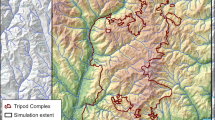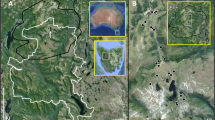Abstract
An explicitly spatial, large scale, high resolution model of fire driven landscape dynamics in the Great Victoria Desert is constructed and parameterized to simulate frequency distributions of fire size and shape obtained from previous analyses of satellite chronosequences. We conclude that probabilities of fire spread cannot be constant over time, and that realistic distributions of fire size and plausible rates of fire spread can be obtained by assuming that fire spread is conditional on observed durations of windy conditions. Landscapes subject to this form of disturbance show large scale correlation structure many times greater than the average dimensions of single fires, and exhibit low frequency quasi-periodic stochastically driven oscillations in proportions of the landscape at different successional states over spatial scales exceeding 100,000 km2. Average fire return intervals are ∼30 yrs. Analysis of patch structure suggests that this landscape is composed of few large younger patches, embedded in a mature sea of surrounding habitat. Intermediate and late successional habitat must exist in more abundant patches somewhat smaller than young habitat. Numerous small patches of mature habitat are likely to be scattered throughout this younger habitat. The model predicts that fire size frequency distributions are relatively insensitive to changes of as much as ±50% of observed fire ignition frequency.
Similar content being viewed by others
References
Antonovski, M.Y., Ter-Mikaelian, M.T. and Furyaev, V.V. 1992. A spatial model of long term forest fire dynamics and its applicationsbl to forests in Western Siberia. Pp. 373–403. In A systems Analysis of the Global Boreal Forest. Edited by Shugart, H.H., Leemans, R. and Bonan, G.B. Cambridge University Press, Cambridge.
Abarbanel, H.D.I., Brown, R., Sodorowich, J.J. and Tsimring, L.S. 1993. The analysis of observed and chaotic data in physical systems. Rev. Modern Phys. 65: 1331–1393.
Baker, W.L., Egbert, S.L. and Frazier, G.F. 1991. A spatial model for studying the effects of climatic change on the structure of landscapes subject to large disturbances. Ecol Model 56: 109–125.
Baker, W.L. 1993. Spatially heterogenous multi-scale response of landscapes to fire suppression. Oikos 66: 6–71.
Baker, W.L. 1994. Restoration of landscape structure altered by fire suppression. Conserv Biol 8: 763–769.
Boychuk, D., Perera, A.H., Ter Mikaelian, M., Martell, D.L and Li, C. 1997. Modelling the effect of spatial scale and correlated fire disturbances on forest age distribution. Ecol Model 95: 145–164.
Bradstock, R.A. and Gill, A.M. 1993. Fire in semi-arid Mallee shrublands: size of flames from discrete fuel arrays and their role in the spread of fire. Int J Wildland Fire 3: 3–12.
Bradstock, R.A., Bedward, M., Scott, J. and Keith, D.A. 1996. Simulation of the effect of spatial and temporal variation in fire regimes on the population viability of a Banksia species. Conserv Biol 10: 776–784.
Broomhead, D.S. and King, G.P. 1986. Extracting qualitative dynamics from experimental data. Physica 20D: 217–236.
Broomhead, D.S., Jones, R. and King, G.P. 1988. Comment on 'singular-value decomposition and embedding dimension'. Phys Rev A37: 5004–5005.
Burrows, N., Ward, B. and Robinson, A. 1991. Fire behaviour in spinifex fuels on the Gibson Desert Nature Reserve, Western Australia. J Arid Environ 20: 189–204.
Chatfield, C. 1996.The analysis of times series: an introduction. Chapman and Hall, New York.
Cheney, N.P., Gould, J.S. and Catchpole, W.R. 1993. The influence of fuel, weather and fire shape variables on fire spread in grasslands. Int J Wildland Fire 3: 31–44.
Cheney, N.P. and Gould, J.S. 1995. Fire growth in grassland fuels. Int J Wildland Fire 5: 237–247.
Davis, F.W. 1993. Introduction to spatial statistics. Pp. 16–26. In Patch Dynamics. Edited by Levin, S.A., Powell, T.M. and Steele, J.H. Springer-Verlag, Berlin.
Gardner, R.H., Hargrove, W.W., Turner, M.G. and Romme, W.H. 1996. Global change disturbances and landscape dynamics. Pp. 149–172. In Global change and terrestrial ecosystems. Edited by Walker, B. and Steffen, W. Cambridge University Press, Cambridge.
Gill, A.M., Burrows, N.D. and Bradstock, R.A. 1995. Fire modelling and fire weather in an Australian desert. CALMScience Suppl 4: 29–34.
Gill, A.M. and Williams, J.E. 1996. Fire regimes and biodiversity–the effects of fragmentation of southeastern Australian eucalypt forests by urbanization, agriculture and pine plantations. For Ecol Manage 85: 261–278.
Green, D.G. 1989. Simulated effects of fire, dispersal and spatial pattern on competition within forest mosaics. Vegetatio 82: 139–153.
Griffin, G.F., Price, N.F. and Portlock, H.F. 1983. Wildfires in the central Australian rangelands 1970–1980. J Environ Manage 17: 311–323.
Griffin, G.F. and Allan, G.E. 1984. Fire behaviour. Pp. 55–68. In Anticipating the Inevitable: a Patch Burn Strategy for Fire Management at Uluru (Ayers Rock-Mt Olga) National Park. Edited by Saxon, E. CSIRO Australia, Melbourne.
Griffin, G.F., Morton, S.R. and Allan, G.E. 1988. Fire-created patch-dynamics for conservation management in the hummock grasslands of central Australia. Proc. International Grasslands Symposium, Huhhot, China.
Hansson, L., Fahrig, L. and Merriam, G. (eds). 1995. Mosaic landscapes and ecological processes. Chapman and Hall, London.
Haydon, D.T., Friar, J. and Pianka, E.R. 1999. Fire Driven Dynamic habitat mosaics in the Great Victoria Desert: I. Fire Geometry. Landscape Ecol 14: 373–381.
Huston, M.A. 1996. Biological Diversity: The Coexistence of Species on Changing Landscapes. Cambridge University Press, Cambridge.
Isham, V. 1991. Assessing the variability of stochastic epidemics. Math Biosci 107: 209–224.
Iwasa, Y. and Kubo, T. 1995. Forest gap dynamics and partially synchronized disturbances and patch age distribution. Ecol Model 77: 257–271.
Johnson, E.A. 1979. Fire recurrence in the subarctic and its implications for vegetation composition. Can J Bot 57: 1374–1379.
Johnson, E.A. 1991. Fire and Vegetation Dynamics. Studies from the North American Boreal Forest. Cambridge Studies in Ecology. Cambridge University Press, Cambridge.
Johnson, E.A. and Gutsell, S.L. 1991. Fire frequency models, methods and interpretations. Adv Ecol Res 25: 239–287.
Johnson, E.A. and Van Wagner, C.E. 1984. The theory and use of two fire history models. Can J For Res 15: 214–220.
Kendall, D.G. 1956. Deterministic and stochastic epidemics in closed populations. Proc Third Berkeley Symp Math. Statist and Prob 4: 149–165.
Kimber, R. 1983. Back lightning: Aborigines and fire in central Australia and the Western Desert. Archeology in Oceania 18: 38–45.
Li, C. and Apps, M.J. 1996. Effects of contagious disturbance on forest temporal dynamics.Ecol Model 87: 143–151.
Li, C., TerMikaelian, M. and Perera, A. 1997. Temporal disturbance patterns on a forest landscape. Ecol Model 99: 137–150.
Lindenmayer, D.B. and Possingham, H.P. 1995. Modelling the impacts of wildfire on the viability of metapopulations of the endangered Australian species of arboreal marsupial, Leadbeaters possum. For Ecol Manage 74: 197–222.
McArthur, A.G. 1972. Fire control in arid and semi-arid lands of Australia. In The Use of Trees and Shrubs in the Dry Country of Australia. Edited by N. Hall et al. Australian Government Publishing Service, Canberra.
Mckenzie, D., Peterson, D.L. and Alvarado, E. 1996. Extrapolation problems inmodelling fire effects at large spatial scales: a review. Int J Wildland Fire 6: 165–176.
Mees, A.I., Rapp, P.E. and Jennings, L.S. 1987. Singular-value decomposition and embedding dimension. Phys Rev A36: 340–341.
Minnich, R.A. and Chou, Y.H. 1997. Wildland fire patch dynamics in the chaparral of southern California and Northern Baja California. Int J Wildland Fire 7: 221–248.
Moloney, K.A. and Levin, S.A. 1996. The effects of disturbance architecture on landscape-level population dynamics. Ecology 77: 375–394.
Morton, S.R., Smith, D.M.S., Friedel, M.H., Griffin, G.F. and Pickup, G. 1995. The stewardship of arid Australia: ecology and landscape management. J Environ Manage 43: 195–217.
Nash, C.H. and Johnson, E.A. 1996. Synoptic climatology of lightening-caused forest fires in subalpine and boreal forests. Can J For Res 26: 1859–1874.
O'Neill, R.V., Gardner, R.H., Turner, M.G. and Romme, W.H. 1992. Epidemiology theory and disturbance spread on landscapes. Landscape Ecol 7: 19–26.
Paine, R.T. and Levin, S.A. 1981. Intertidal landscape:disturbance and the dynamics of pattern. Ecol Monogr 51: 145–178.
Palus, M and Dvorak, I. 1992. Singular-value decomposition in attractor reconstructions: pitfalls and precautions. Physica D55: 221–234.
Pianka, E.R. 1996. Long-term changes in lizard assemblages in the Great Victoria desert: Dynamic habitat mosaics in response tow-ildfires. Pp. 191–21. In Long-Term Studies of Vertebrate Communities. Edited by Cody, M.L. and Smallwood, J.A. Chapter 8, Academic Press, New York.
Pickett, S.T.A. and White, P.S. 1985. The ecology of natural disturbance and patch dynamics. Academic Press, New York.
Rand, D.A. and Wilson, H.B. 1995. Using spatio-temporal chaos and intermediate-scale determinism to quantify spatially extended ecosystems. Proc R Soc Lond Ser B Biol Sci 259: 111–117.
Ratz, A. 1995. Long-term spatial patterns created by fire: A model oriented towards boreal forest. Int J Wildland Fire 5: 25–34.
Reed, W.J., Larsen, C.P.S., Johnson, E.A. and MacDonald, G.M. 1998. Estimation of temporal variations in historical fire frequency from time since fire map data. For Sci 44: 465–475.
Romme, W.H. 1982. Fire and landscape diversity in subalpine forests of Yellowstone National Park. Ecol Monogr 52: 199–221.
Russellsmith, J., Ryan, P.G. and Durieu, R. 1997. A landsat MSS-derived fire history of Kakadu National Park, monsoonal northern Australia, 1980–94–seasonal extent, frequency and patchiness. J Appl Ecol 34: 748–766.
Schimmel, J. and Granstrom, A. 1997. Fuel succession and fire behavior in the Sedish boreal forest. Can J For Res 27: 1207–1216.
Stauffer, D. and Aharony, A. 1992. Introduction to percolation theory. Taylor and Francis, New York.
Taylor, D.L. 1973. Some ecological implications of fire control in Yellowstone National Park. Ecology 54: 1394–1396.
Turner M.G., Romme, W.H. and Gardner, H. 1994a. Landscape disturbance models and the long-term dynamics of natural areas. Nat Areas J 14: 3–11.
Turner M.G., Hargrove, W.W., Gardner, R.H. and Romme, W.H. 1994b. Effects of fire on landscape heterogeneity in Yellowstone National Park, Wyoming.J Veg Sci 5: 731–742.
Turner M.G., Romme, W.H., Gardner, R.H. and Hargrove, W.W. 1997.Effects of fire size and pattern on early succession in Yellowstone National Park. Ecol Monogr 67: 411–433.
Van Wagner, C.E. 1978. Age-class distribution and the forest fire cycle. Can J For Res 8: 220–227.
Wallin, D.O., Swanson, F.J., Marks, B., Cissel, J.H. and Kertis, J. 1996. Comparison of managed and pre-settlement landscape dynamics in forests of the Pacific Northwest USA. For Ecol Manage 85: 291–309.
Wu, Y., Sklar, F.H., Gopu, K. and Rutchey, K. 1996. Fire simulations in the Everglades landscape using parallel programming. Ecol Model 93: 113–124.
Author information
Authors and Affiliations
Rights and permissions
About this article
Cite this article
Haydon, D.T., Friar, J.K. & Pianka, E.R. Fire-driven dynamic mosaics in the Great Victoria Desert, Australia – II. A spatial and temporal landscape model. Landscape Ecology 15, 407–423 (2000). https://doi.org/10.1023/A:1008128214176
Issue Date:
DOI: https://doi.org/10.1023/A:1008128214176




